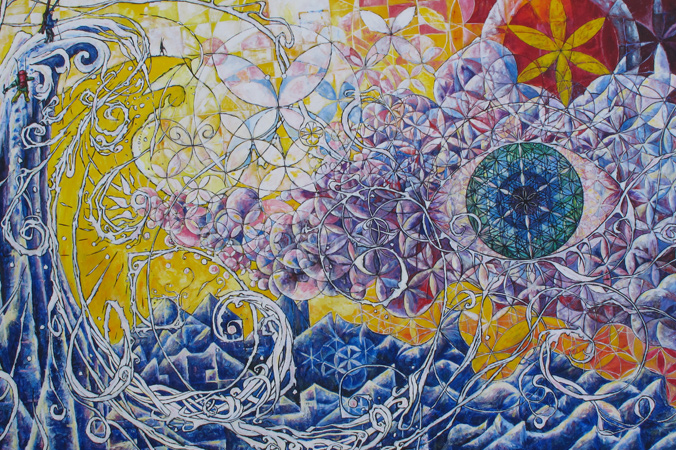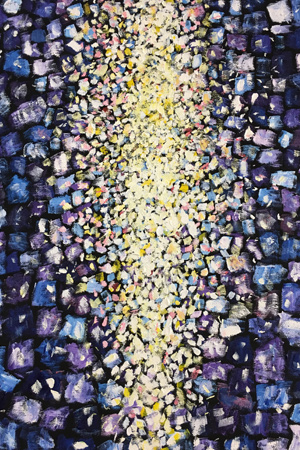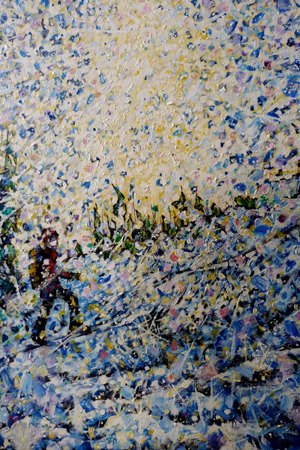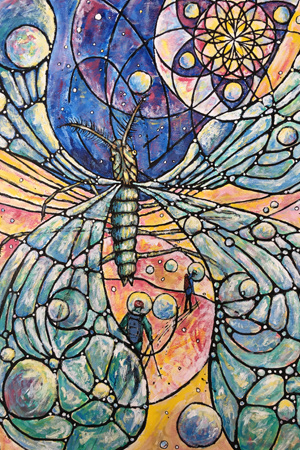Artist and ACMG-certified guide, Aaron Enns, 40, hails from Golden, B.C., where he looks to his skintrack-based work in the winter and tree-planting vocation in the summer as fuel for his creative juices. Through incorporating the natural, repeating patterns and fractal geometry that appear in the familiar backcountry scenery of his workday, he aims to paint his home mountains in a new light. We caught up with him to learn more about his process, his inspiration and how his art and outdoor lifestyle continue to feed off each other.

Image Title: The spirituality of skiing
Backcountry Magazine: Tell me about your background and how you got started as an artist.
Aaron Enns: My quick life story is that I’ve loved art ever since I was a little kid—it was my first passion. I studied art for a couple of years in Vancouver at Emily Carr University of Art and Design, but at a certain point, I had to decide between going into debt or having fun with my life, so I lived out of a backpack, checked out permaculture design, yoga and Buddhist meditation before finally settling down back in Golden, B.C.
After I went to Art College, it overwhelmed me and drained away the fun of it. It was like everything had to have deep political content. After I finished school, I found myself just wanting to make nice paintings that inspire people to be out in nature. Eventually, I put my art on pause for a little while, but in the last ten years I’ve rediscovered my love for it again. I’ve been working on acrylic painting and trying to combine painting with my outdoor lifestyle.
And recently, I’ve been trying to tie in aspects of sacred geometry and the fractal aspects of life. There are repeating patterns in life and nature all over the mountains and I’m trying to tie those patterns into my work.

Image Title: Snow Spirit
BCM: What is your skiing background?
AE: I got into skiing and ski racing when I was younger, but I started skiing full time in 2000 at Kicking Horse Mountain Resort. I spent a bunch of time with ski patrol and did a bit of avalanche forecasting for the CP Rail—Canadian Pacific Railway—in Golden. I also put in time at some lodges: Bald Face Lodge, Mica Heli Skiing, Golden Alpine Holidays Lodges. Those jobs were all as tail guides or practicums, just getting into the ski-guiding thing.
Now I’m specifically focusing on touring work. I try to keep it on the greener side of things—not burning too many fossil fuels—and gravitate toward more human-powered activities. I love introducing people to ski touring, freeriding, steep skiing and ski mountaineering.

Image Title: Snow Storm
BCM: How do you think your clients or your guide lifestyle factors into your work?
AE: I like comparing ski guiding, and, specifically, setting an uptrack and moving uphill through the mountains, to doing a line drawing. I try to make the skintrack flow and move uphill like it would in a nice drawing. And in drawing or painting, I try to allow the painting to dictate where I go to some degree.
I flow through art, the skintrack and life, but at the same time don’t want to bump into a barrier—physical or mental—so I need to anticipate what’s coming and be ready for whatever’s around the next corner.
BCM: Do you speak about this other part of your life with the people that you guide?
AE: Yeah, I think they’re interested and excited about it, actually. They seem to like having a multi-faceted guide. Occasionally I’ve had trips where I’ve gotten photos with the clients, and I’ve made art based on those images. People always get a kick out of that, seeing themselves in a piece of art.

Image Title: Planet Tree
BCM: Could you speak a little bit to your process? What’s your preferred method and medium?
AE: I start with either a photo or just a simple sketch of the idea, and then I’ll usually play with that. I generally have a concept when I start a new project, but I leave lots of room for things to change and stay dynamic as I’m working on pieces. It’s interesting; one of the cruxes for me is deciding when my work is finished. I will often put work up on the wall for a week or two, look at it, come back and find I can keep changing it, but eventually all the changes bring it back to where I began, so it hasn’t evolved anymore.
BCM: Do you ever go outside and receive another layer of inspiration that will cause you to keep adding to one piece?
AE: Yeah, I definitely build up layers in my work. I’ll pick a landscape, and then I think of elements to incorporate into it like movement, wind and snow. I like working on trying to have a dynamic airspace in my paintings, so people can see the movement of the wind and the air.

Image Title: Snow midge with ski tourers
BCM: How do you think your work has evolved over the years?
AE: I’ve gotten more confident in just trusting what I want to do and not necessarily worrying about what other people have told me to do in the past. I use a bolder color scheme and recently, I’ve been incorporating more line work into my acrylic paintings. I’m running up against this challenge where I like the abstract or impressionist styles, which are pretty free and loose, but, at the same time, I want to tie in fractal geometry. That means I’m trying to tighten up this loose style of painting. That’s the battle I fight when working on my pieces, especially the ones with more line work in them.
BCM: Once skiing is done for the season, what do you do in late summer and early fall?
AE: I’m a tree planter. I had a great day yesterday; I planted three and a half thousand trees and came home happy. Maybe tomorrow it’s going to be a thousand trees and mosquitoes and slash up to my eyeballs.

Image Title: Steep Skiing
BCM: Does that part of your life ever filter into your artwork?
AE: Yeah, totally. I like the tree planting, because you’re your own boss out there. People check up on what you’re doing, but you spend a lot of time by yourself. I’ve got beautiful views of all our local mountain ranges. Yesterday we were working in the Rocky Mountains, looking at some nice big peaks and those all get incorporated into my art. The tree planting also gives me lots of exposure to the local mountain ranges that give me new ideas on where to ski and go on adventures. There are always trees popping up in my artwork.
BCM: Is there one instance or one day in the backcountry that clearly inspired you and your artwork?
AE: There are specific moments when everything is super dynamic. The sun is in the right spot; you have the sunbeams and the clouds and there’s wind and it blows the snow up in the air and people’s shadows are getting cast through the mist. I’ll take the image back home with me and draw it. I love capturing those moments in nature when everything is alive, vibrant and active.











Related posts:
Skintrack Sketches: Skiing, art and loss through the eyes of Sandra Fransson
Skintrack Sketches: Gianna Andrews takes the silver linings in life and paints them
Skintrack Sketches: Swiss artist Corinne Weidmann explores layers in the landscape
Skintrack Sketches: Mimi Kvinge looks to balance authentic artistic identity and brand